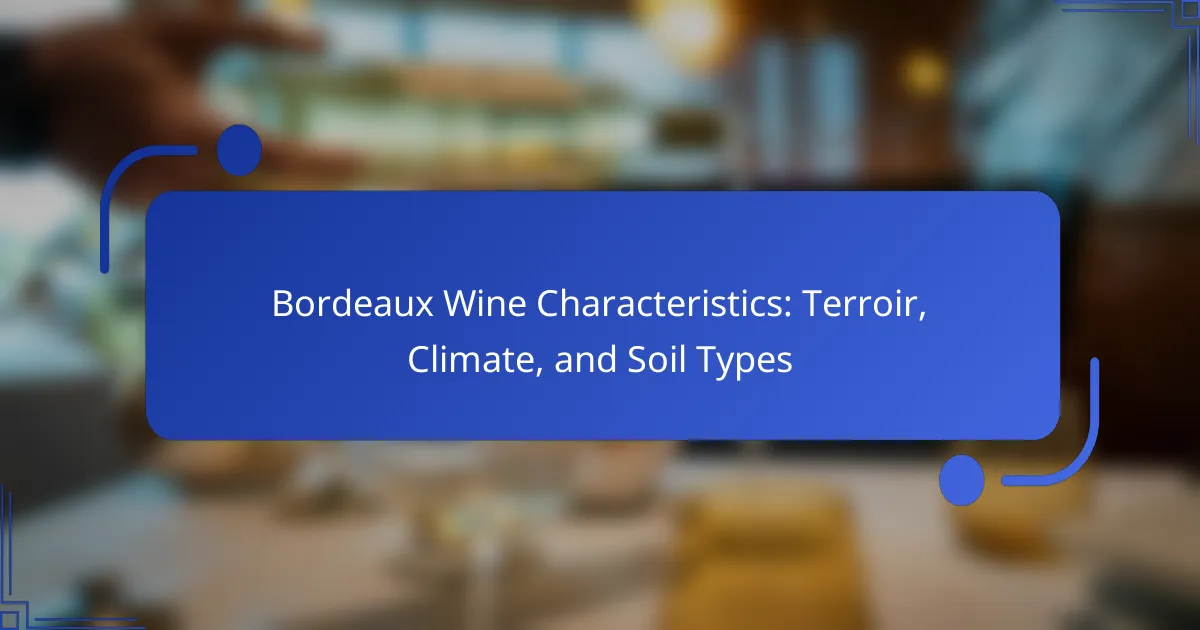
What are the key characteristics of Bordeaux wine?
Bordeaux wine is known for its rich flavors and complexity. It typically features a blend of grape varieties, primarily Cabernet Sauvignon, Merlot, and Cabernet Franc. The wine exhibits a deep color, often ruby or garnet. Bordeaux wines are characterized by their balanced acidity and tannins. The region’s unique terroir contributes to the wine’s distinct taste profile. Bordeaux wines often display notes of dark fruits, such as blackcurrant and plum. Aging in oak barrels adds layers of vanilla and spice. The climate of Bordeaux is maritime, providing a long growing season that enhances flavor development.
How does terroir influence Bordeaux wine characteristics?
Terroir significantly influences Bordeaux wine characteristics through its unique combination of climate, soil, and geographical location. The climate in Bordeaux is maritime, with moderate temperatures and rainfall, which affects grape ripening. Soil types, ranging from gravel to clay, contribute to the drainage and nutrient availability for the vines. This diversity in terroir results in a wide range of flavor profiles in the wines. For example, wines from gravel soils often exhibit more minerality, while clay soils tend to produce fuller-bodied wines. Additionally, the proximity to the Gironde estuary moderates temperature fluctuations, promoting consistent grape quality. Historical practices in Bordeaux also emphasize the importance of terroir, with specific regions known for distinct varietals, such as Cabernet Sauvignon and Merlot. This interplay of factors leads to the complex characteristics that define Bordeaux wines.
What elements define the terroir of Bordeaux?
The terroir of Bordeaux is defined by three main elements: soil, climate, and topography. The soil in Bordeaux varies, including gravel, clay, and limestone, which influences vine growth. The climate is classified as maritime, characterized by mild winters and warm summers. This climate supports the cultivation of grape varieties like Merlot and Cabernet Sauvignon. Topography in Bordeaux includes rolling hills and valleys, affecting drainage and sunlight exposure. These elements collectively contribute to the unique flavor profiles of Bordeaux wines. The diversity of terroir is essential for the region’s reputation and quality of wine production.
How does terroir affect the flavor profile of Bordeaux wines?
Terroir significantly influences the flavor profile of Bordeaux wines. Terroir encompasses the unique combination of soil, climate, and topography in a specific region. Bordeaux’s diverse terroir results in a wide range of flavor profiles. For example, gravel soils enhance the ripeness and fruitiness of Cabernet Sauvignon. Clay soils contribute to the richness and structure of Merlot. The maritime climate of Bordeaux moderates temperatures, allowing grapes to develop complex flavors. Additionally, the region’s varying elevations affect sunlight exposure and drainage, further influencing grape characteristics. Studies show that wines from different Bordeaux appellations exhibit distinct sensory profiles linked to their terroir. This interplay of environmental factors ultimately shapes the unique taste of Bordeaux wines.
What role does climate play in Bordeaux wine production?
Climate significantly influences Bordeaux wine production. The region experiences a temperate maritime climate. This climate provides warm summers and mild winters. Such conditions are ideal for grape ripening. Rainfall patterns also affect vineyard health and grape quality. Bordeaux typically receives sufficient rainfall, but drought can occur. The proximity to the Atlantic Ocean moderates temperature fluctuations. This results in a longer growing season. Overall, the climate contributes to the unique flavor profiles of Bordeaux wines.
What are the climatic conditions in the Bordeaux region?
The climatic conditions in the Bordeaux region are characterized by a maritime climate. This climate features mild winters and warm summers. Average temperatures range from 8°C in winter to 24°C in summer. The region receives about 800 mm of rainfall annually, with most precipitation occurring in late spring and autumn. The proximity to the Atlantic Ocean moderates temperature extremes. Additionally, the Gironde estuary influences local weather patterns. These factors contribute to the region’s suitability for grape growing, enhancing the quality of Bordeaux wines.
How do seasonal variations impact grape growth in Bordeaux?
Seasonal variations significantly impact grape growth in Bordeaux. Temperature fluctuations influence the timing of bud break and flowering. Warmer springs can lead to earlier bud break, while cooler temperatures may delay it. Summer heat affects grape ripening and sugar accumulation. Optimal temperatures during summer promote healthy growth and balanced acidity. Autumn weather determines harvest timing and grape quality. Rainfall during this season can dilute flavors and increase disease risk. Historical data shows that consistent seasonal patterns contribute to the region’s renowned wine quality. For instance, Bordeaux’s average temperature during the growing season has increased by 1.5°C over the past 50 years, affecting grape phenology.
What types of soil are found in Bordeaux and how do they affect wine?
Bordeaux features several types of soil that significantly influence its wine production. The primary soil types include gravel, clay, limestone, and sand. Gravel soils, found in the Médoc region, provide excellent drainage and heat retention, benefiting Cabernet Sauvignon. Clay soils, prevalent in areas like Pomerol, retain moisture and nutrients, enhancing Merlot’s growth. Limestone soils, present in regions such as Saint-Émilion, contribute to the minerality and acidity of wines. Sand soils, located in areas like the Entre-Deux-Mers, promote early ripening and are beneficial for white grape varieties. Each soil type interacts with the climate and grape varieties, shaping the unique flavor profiles of Bordeaux wines.
What are the primary soil types in the Bordeaux region?
The primary soil types in the Bordeaux region include gravel, clay, limestone, and sand. Gravel soils are prevalent in the Left Bank, particularly in the Médoc area. These soils provide excellent drainage and are ideal for Cabernet Sauvignon. Clay soils are found in the Right Bank, especially in areas like Saint-Émilion. They retain moisture and are well-suited for Merlot. Limestone soils are also significant in the Right Bank, contributing to the minerality of the wines. Sand soils are less common but are found in some regions, offering good drainage and warmth. Each soil type influences the characteristics of the wines produced in Bordeaux.
How does soil composition influence grape varieties in Bordeaux?
Soil composition significantly influences grape varieties in Bordeaux. Different soil types affect drainage, nutrient availability, and temperature regulation. Bordeaux features diverse soils, including gravel, clay, limestone, and sand. Gravel soils, found in the Médoc region, are ideal for Cabernet Sauvignon. They provide excellent drainage and retain heat, promoting ripening. Clay soils, prevalent in Saint-Émilion, favor Merlot, as they retain moisture and nutrients. Limestone, found in Pessac-Léognan, benefits both Cabernet Sauvignon and Merlot by providing essential minerals. The unique combination of these soils shapes the flavor profiles and characteristics of Bordeaux wines.
How do the characteristics of Bordeaux wines compare to other wine regions?
Bordeaux wines are known for their balanced structure, rich flavors, and aging potential. They typically feature a blend of grape varieties, mainly Cabernet Sauvignon, Merlot, and Cabernet Franc. In contrast, wines from regions like Burgundy focus on single varietals, such as Pinot Noir and Chardonnay, leading to distinct flavor profiles. Bordeaux’s maritime climate contributes to its fruit-forward characteristics, while regions like Napa Valley have more pronounced ripeness due to a warmer climate. Soil diversity in Bordeaux, including gravel, clay, and limestone, influences the wine’s complexity. Other regions, such as the Rhône Valley, have different soil types that affect the taste and style of their wines. Bordeaux wines generally have higher tannin levels, which aids in aging, compared to the softer tannins found in many wines from cooler regions. This combination of factors makes Bordeaux wines unique when compared to other wine regions worldwide.
What are the implications of terroir, climate, and soil on Bordeaux wine quality?
Terroir, climate, and soil significantly influence Bordeaux wine quality. Terroir encompasses the unique environmental factors of a vineyard. These factors include climate, soil composition, and topography. Bordeaux’s maritime climate provides moderate temperatures and sufficient rainfall. This climate promotes the growth of key grape varieties like Merlot and Cabernet Sauvignon. Soil types in Bordeaux, such as gravel, clay, and limestone, contribute to drainage and nutrient availability. Gravel soils enhance ripeness and structure in wines. Clay retains moisture, benefiting vine health during dry periods. The combination of these elements results in wines with distinct flavors and aging potential. Studies show that terroir can lead to variations in wine quality even within the same vineyard.
What tips can enhance the appreciation of Bordeaux wines?
To enhance the appreciation of Bordeaux wines, focus on understanding their terroir, climate, and soil types. Bordeaux wines reflect the unique characteristics of their growing regions. Familiarizing yourself with the specific appellations can deepen your knowledge. Tasting wines from different Bordeaux regions highlights the diversity in flavor profiles. Pairing Bordeaux wines with appropriate foods can enhance the tasting experience. Serving Bordeaux wines at the right temperature maximizes their aromatic qualities. Additionally, taking notes during tastings can help track preferences and improve future selections. Engaging with local wine events or tastings can also provide valuable insights and experiences.
Bordeaux wine is characterized by its rich flavors, complexity, and a blend of grape varieties, primarily Cabernet Sauvignon, Merlot, and Cabernet Franc. The article explores the influence of terroir, which encompasses the region’s unique climate, soil types, and topography, on the wine’s characteristics and flavor profiles. It details how Bordeaux’s maritime climate and diverse soil types, including gravel, clay, and limestone, contribute to the quality and aging potential of the wines. Additionally, the article compares Bordeaux wines to those from other regions and offers tips for enhancing appreciation of these wines through understanding their distinct attributes.
